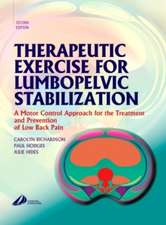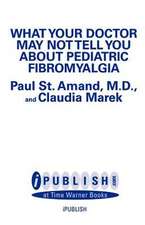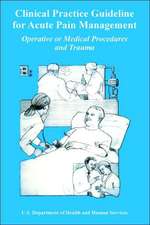Practical Management of Pain
Autor Honorio MD Benzon, James P. Rathmell, Christopher L. Wu, Dennis C. Turk, Charles E. Argoff, Robert W Hurleyen Limba Engleză Hardback – 15 sep 2013
"I would recommend this textbook for all clinicians involved in acute, chronic, and cancer pain medicine. It is a book that I enjoyed reading read from cover to cover, but it would be equally good being dipped into selectively as an aid memoir or when preparing a presentation." Reviewed by British Journal of Anaesthesia, Feb 2015
Preț: 973.35 lei
Preț vechi: 1344.97 lei
-28% Nou
Puncte Express: 1460
Preț estimativ în valută:
186.31€ • 202.44$ • 156.60£
186.31€ • 202.44$ • 156.60£
Carte disponibilă
Livrare economică 04-16 aprilie
Preluare comenzi: 021 569.72.76
Specificații
ISBN-13: 9780323083409
ISBN-10: 0323083404
Pagini: 1144
Ilustrații: Approx. 282 illustrations (167 in full color)
Dimensiuni: 222 x 281 x 39 mm
Greutate: 2.54 kg
Ediția:Revised
Editura: Elsevier
ISBN-10: 0323083404
Pagini: 1144
Ilustrații: Approx. 282 illustrations (167 in full color)
Dimensiuni: 222 x 281 x 39 mm
Greutate: 2.54 kg
Ediția:Revised
Editura: Elsevier
Public țintă
Pain Specialists, Anesthesiologists, PM&R Physicians, Neurologists, and RheumatologistsCuprins
Part I: General Considerations
8. Pain Pathways: Peripheral, Spinal, Ascending and Descending Pathways
9. A Review of Pain Processing Pharmacology
10. Pain and Brain Changes
11. Pharmacogenetics in Pain Management
12. Psychosocial Aspects of Chronic Pain
Part III. Evaluation and Assessment
13. History and Physical Examination of the Pain Patient
14. Electromyography and Evoked Potentials
15. Radiologic Assessment of the Patient with Spine Pain
16. Psychological and Behavioral Assessment
17. Disability Assessment
Part IV. Clinical Conditions
18. Postoperative Pain and Other Acute Pain Syndromes
19. The Prediction and Prevention of Persistent Post-Surgical Pain
20. Pediatric Acute Pain Management
21. Low Back Pain
22. Neurosurgical Approaches to Pain Management
23. Cancer Pain
24. Neuropathic Pain Syndromes
25. Pain in Selected Neurologic Disorders
26. Phantom Limb Pain
27. Central Post-Stroke Pain Syndrome
28. Spinal Cord Injury Pain
29. Chronic Widespread Pain
30. Headache Management
31. Dental and Facial Pain
32. Visceral Pain
33. Pediatric Chronic Pain Management
34. The Management of Pain in Older Adults
35. Managing Pain During Pregnancy and Lactation
Part V. Pharmacological, Psychological, and Physical Medicine Treatments
36. Major Opioids and Chronic Opioid Therapy
37. Minor and Short-Acting Analgesics, Including Opioid Combination Products
38. Antidepressants as Analgesics
39. Membrane Stabilizers for the Treatment of Pain
40. Nonsteroidal Anti-inflammatory Drugs, Acetaminophen, and COX-2 Inhibitors
41. Skeletal Muscle Relaxants
42. Topical Analgesics
43. Neuraxial Agents
44. Pharmacology for the Interventional Pain Physician
45. Psychological Interventions
46. Physical Medicine Techniques in Pain Management
47. Physical Rehabilitation for Patients with Chronic Pain
48. Acupuncture
49. Integrative Approaches to Pain Management
50. Pain and Addictive Disorders: Challenge and Opportunity
51. Issues with Opioid Use
Part VI. Nerve Block Techniques
52. Head and Neck Blocks
53. Upper Extremity Blocks
54. Lower Extremity Nerve Blocks
55. Truncal Blocks
56. Peripheral and Visceral Sympathetic Blocks
57. Intraarticular Analgesia
58. Chemical Neurolytic Blocks
59. Neurolysis of the Sympathetic Axis for Cancer Pain Management
Part VII. Interventional Techniques
60. Interlaminar and Transforaminal Therapeutic Epidural Injections
61. Pathogenesis, Diagnosis, and Treatment of Zygapophysial (Facet) Joint Pain
62. Radiofrequency Treatment
63. Sacroiliac Joint Syndrome: Sacroiliac Joint Injections and Block/Radiofrequency
of the Lateral Branch Blocks
64. Myofascial Injections: Trigger Point, Piriformis, Iliopsoas, and Scalene Injections
65. Lumbar Discogenic Pain and Discography
66. Intradiscal Procedures for the Treatment of Discogenic Lower Back and Leg Pain
67. Minimally Invasive Procedures for Vertebral Compression Fractures
68. Biopsychosocial Pre-Screening for Spinal Cord and Peripheral Nerve Stimulation
69. Spinal Cord and Peripheral Nerve Stimulation
70. Intrathecal Drug Delivery: Patient Selection, Trialing, and Implantation
71. Joint Injections
72. Radiation Safety and Use of Radiographic Contrast Agents in Pain Medicine
Part VIII. Pain Management in Special Situations and Special Topics
73. The Management of Pain from Sickle Cell Disease
74. Burn Pain
75. Pain Management in the Emergency Department
76. Pain Management in the Critically Ill Patient
77. Pain Management at the End of Life
78. Home Care
79. The Health Implications of Disparities in Cancer and Pain Care: Unequal Burdens
and Unheard Voices
Part IX: Research, Ethics, and Reimbursement in Pain
80. Clinical Trial Design Methodology for Pain Outcome Studies
81. Ethics of Research in Patients with Pain
82. Postoperative Pain Management: Trends and Future Directions and Areas in Need
of Investigations
83. Future Directions and Trends in Pain Medicine
- The History of Pain Medicine
- Taxonomy and Classification of Chronic Pain Syndromes
- Organizing an Inpatient Acute Pain Service
- Measurement-Based Stepped Care Approach to Interdisciplinary Chronic Pain Management
- The Healthcare Policy of Pain Management
- Quality Assurance and Improvement and Patient Safety in the Pain Clinic
- Education, Training, and Certification in Pain Medicine
8. Pain Pathways: Peripheral, Spinal, Ascending and Descending Pathways
9. A Review of Pain Processing Pharmacology
10. Pain and Brain Changes
11. Pharmacogenetics in Pain Management
12. Psychosocial Aspects of Chronic Pain
Part III. Evaluation and Assessment
13. History and Physical Examination of the Pain Patient
14. Electromyography and Evoked Potentials
15. Radiologic Assessment of the Patient with Spine Pain
16. Psychological and Behavioral Assessment
17. Disability Assessment
Part IV. Clinical Conditions
18. Postoperative Pain and Other Acute Pain Syndromes
19. The Prediction and Prevention of Persistent Post-Surgical Pain
20. Pediatric Acute Pain Management
21. Low Back Pain
22. Neurosurgical Approaches to Pain Management
23. Cancer Pain
24. Neuropathic Pain Syndromes
25. Pain in Selected Neurologic Disorders
26. Phantom Limb Pain
27. Central Post-Stroke Pain Syndrome
28. Spinal Cord Injury Pain
29. Chronic Widespread Pain
30. Headache Management
31. Dental and Facial Pain
32. Visceral Pain
33. Pediatric Chronic Pain Management
34. The Management of Pain in Older Adults
35. Managing Pain During Pregnancy and Lactation
Part V. Pharmacological, Psychological, and Physical Medicine Treatments
36. Major Opioids and Chronic Opioid Therapy
37. Minor and Short-Acting Analgesics, Including Opioid Combination Products
38. Antidepressants as Analgesics
39. Membrane Stabilizers for the Treatment of Pain
40. Nonsteroidal Anti-inflammatory Drugs, Acetaminophen, and COX-2 Inhibitors
41. Skeletal Muscle Relaxants
42. Topical Analgesics
43. Neuraxial Agents
44. Pharmacology for the Interventional Pain Physician
45. Psychological Interventions
46. Physical Medicine Techniques in Pain Management
47. Physical Rehabilitation for Patients with Chronic Pain
48. Acupuncture
49. Integrative Approaches to Pain Management
50. Pain and Addictive Disorders: Challenge and Opportunity
51. Issues with Opioid Use
Part VI. Nerve Block Techniques
52. Head and Neck Blocks
53. Upper Extremity Blocks
54. Lower Extremity Nerve Blocks
55. Truncal Blocks
56. Peripheral and Visceral Sympathetic Blocks
57. Intraarticular Analgesia
58. Chemical Neurolytic Blocks
59. Neurolysis of the Sympathetic Axis for Cancer Pain Management
Part VII. Interventional Techniques
60. Interlaminar and Transforaminal Therapeutic Epidural Injections
61. Pathogenesis, Diagnosis, and Treatment of Zygapophysial (Facet) Joint Pain
62. Radiofrequency Treatment
63. Sacroiliac Joint Syndrome: Sacroiliac Joint Injections and Block/Radiofrequency
of the Lateral Branch Blocks
64. Myofascial Injections: Trigger Point, Piriformis, Iliopsoas, and Scalene Injections
65. Lumbar Discogenic Pain and Discography
66. Intradiscal Procedures for the Treatment of Discogenic Lower Back and Leg Pain
67. Minimally Invasive Procedures for Vertebral Compression Fractures
68. Biopsychosocial Pre-Screening for Spinal Cord and Peripheral Nerve Stimulation
69. Spinal Cord and Peripheral Nerve Stimulation
70. Intrathecal Drug Delivery: Patient Selection, Trialing, and Implantation
71. Joint Injections
72. Radiation Safety and Use of Radiographic Contrast Agents in Pain Medicine
Part VIII. Pain Management in Special Situations and Special Topics
73. The Management of Pain from Sickle Cell Disease
74. Burn Pain
75. Pain Management in the Emergency Department
76. Pain Management in the Critically Ill Patient
77. Pain Management at the End of Life
78. Home Care
79. The Health Implications of Disparities in Cancer and Pain Care: Unequal Burdens
and Unheard Voices
Part IX: Research, Ethics, and Reimbursement in Pain
80. Clinical Trial Design Methodology for Pain Outcome Studies
81. Ethics of Research in Patients with Pain
82. Postoperative Pain Management: Trends and Future Directions and Areas in Need
of Investigations
83. Future Directions and Trends in Pain Medicine











